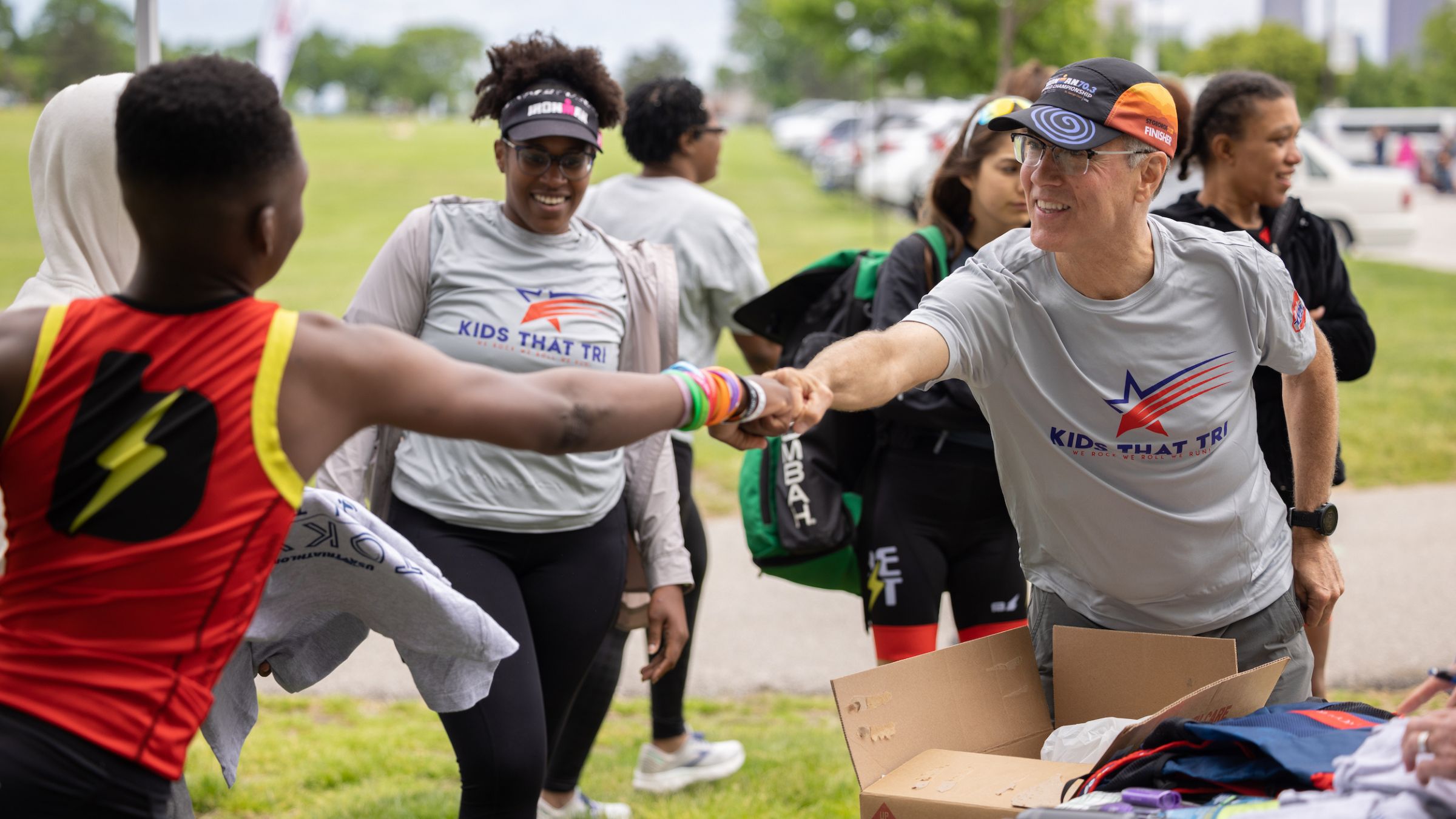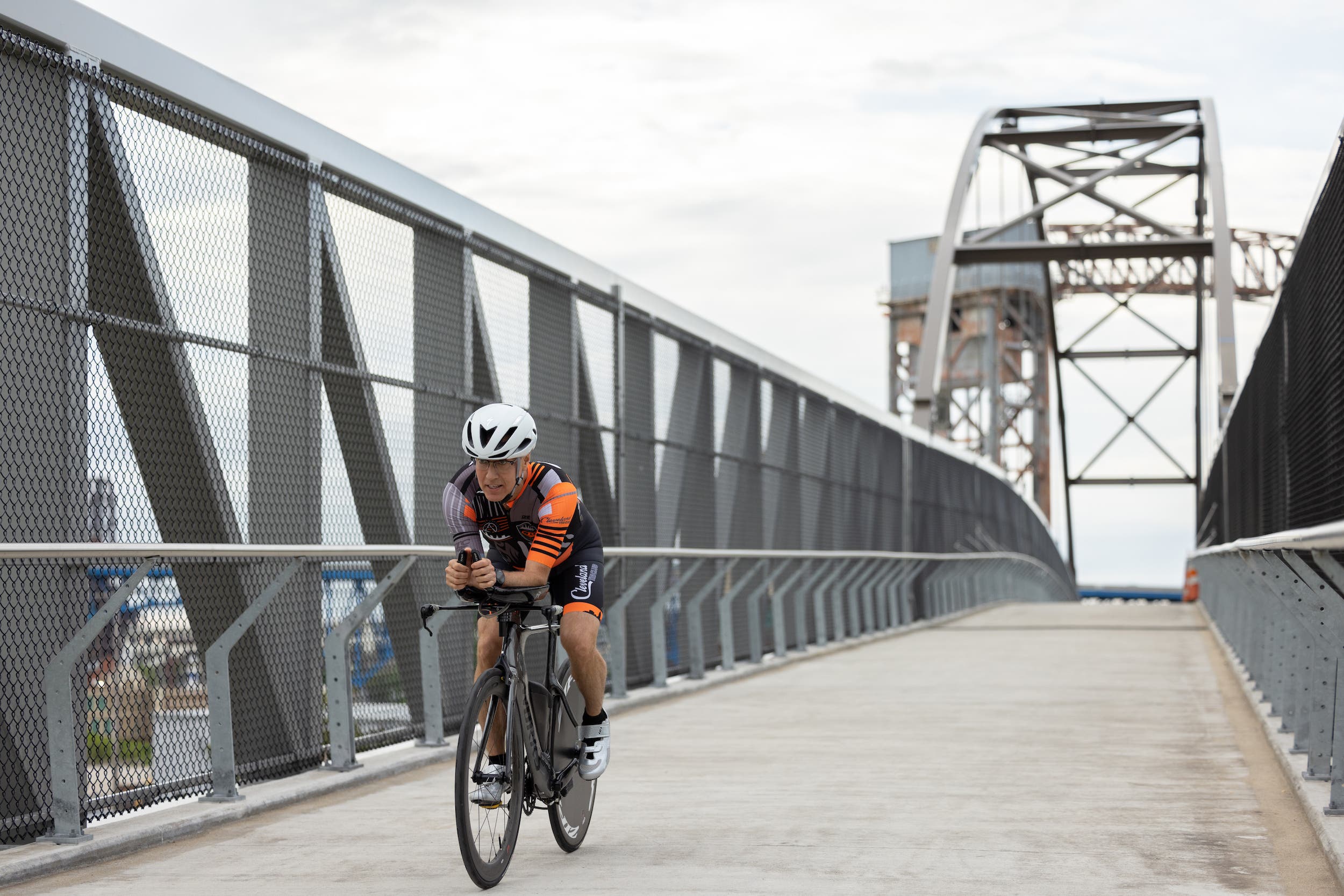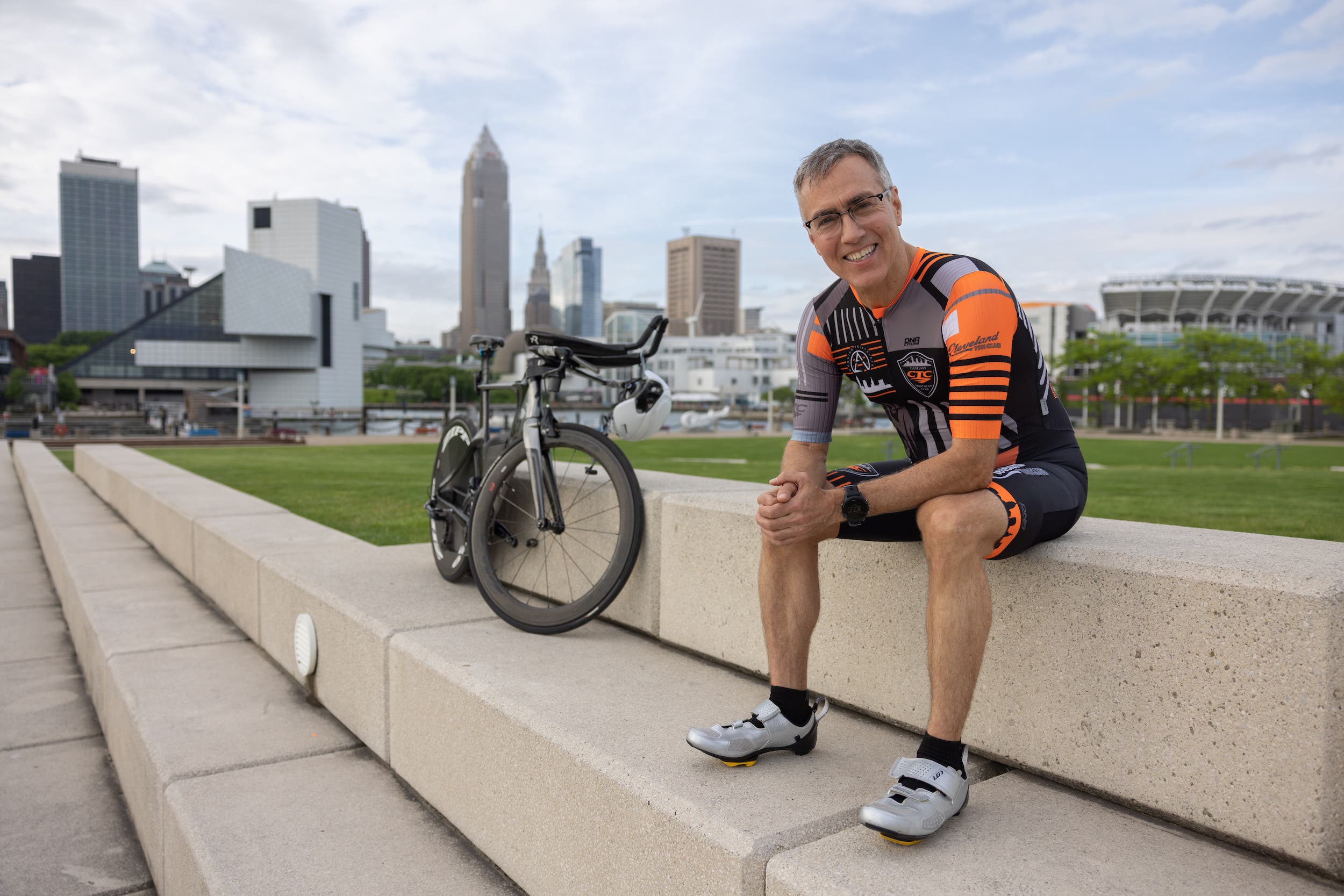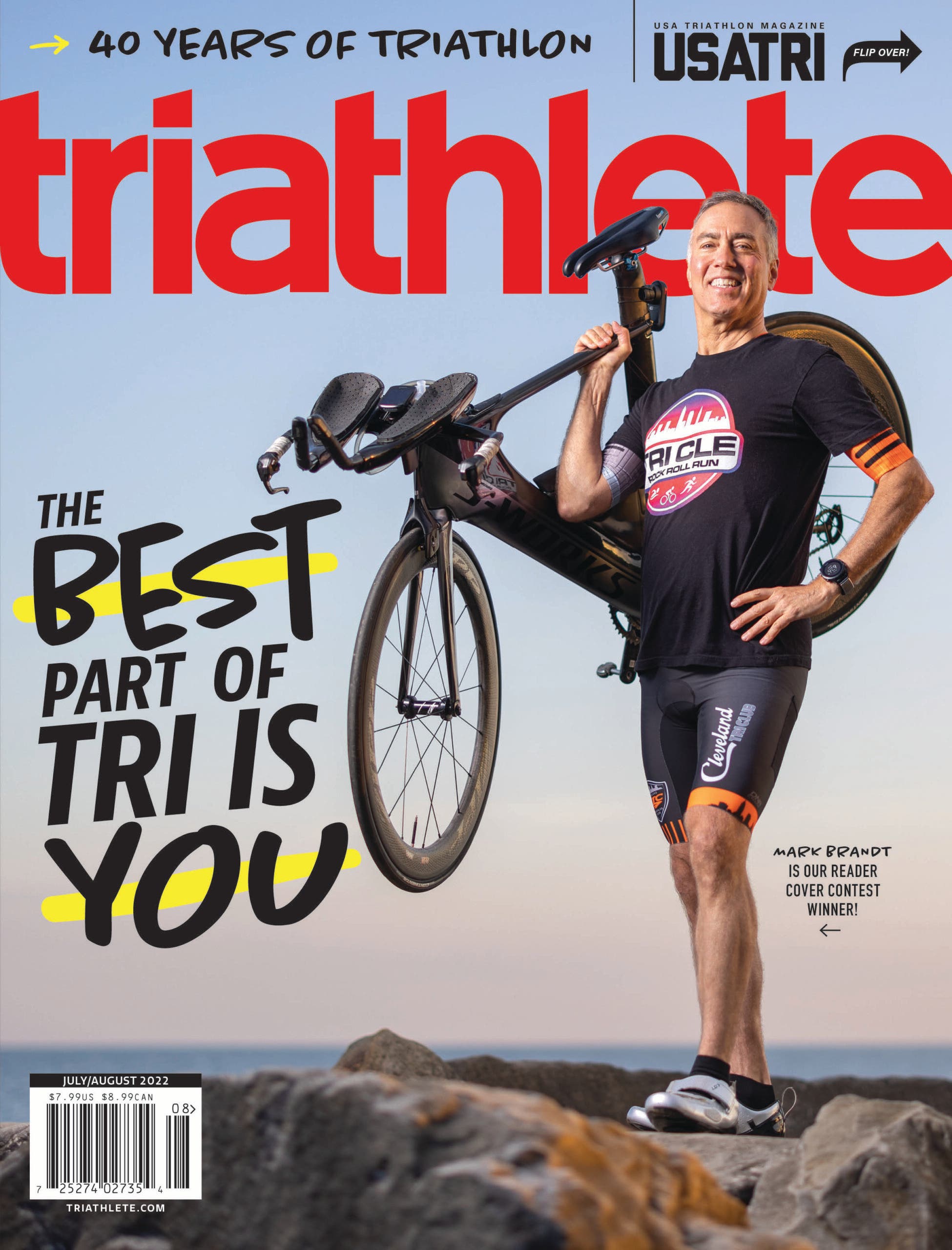Our Cover Contest Winner, Mark Brandt Believes You Can Tri, Too

(Photo: Cody York Photography)
Mark Brandt loves triathlon, and he loves his hometown.
He loves training. He loves racing. He loves his teammates on the Cleveland Triathlon Club and his coach, Cindy Lewis-Caballero—ready to do whatever she says to get faster. He loves bringing people into his sport. He loves showing off his town of Cleveland, Ohio. He loves seeing the kids involved in the nonprofit he started, Kids That Tri, get out there and race, too. Really, he loves just seeing them happy and working hard. He loves it all—the early mornings, the long days, the headaches, the sun coming up over the lake at the start of his brand new race, Tri CLE Rock Roll Run.
“Mark has one of the biggest hearts and he is an amazing athlete,” wrote Mel Prohaska, who nominated him for the cover. “He truly cares about the growth of the sport of triathlon.”
“He is this spitfire, full of energy, super kind and generous, always positive,” said Micaela Gonzalez Kail, one of the coaches for the Kids That Tri program. “This man just doesn’t stop.”
When Brandt travels around during the day, to work or to meetings or to the gym, he always carries extra cards in his pocket promoting Tri CLE’s Rock Roll Run and the Kids That Tri program. You should come out to the race, he tells people, and if they demur, he says, “Come volunteer instead.” He figures he’ll hook them one way or the other, and eventually convince them to swim-bike-run. One way or another, he’ll get them out doing stuff in their communities and living a healthy (and happy) life.
“I’m out there every day talking to people and I’m either looking for racers or volunteers, but just don’t sit on the sofa. Do something,” he said. “A healthy life is a good life.”
Runner turned cyclist turned triathlete
Brandt wasn’t always a triathlete. In fact, he did his first triathlon just nine years ago when he was 50 years old.
Like so many late converts to multisport, Brandt started as a runner growing up. He even did a marathon as a teenager growing up in Cleveland, but then struggled with stomach issues for decades.
It wasn’t until his wife told him to let her try picking his foods for a week, without telling him what she was feeding him, that he found he was gluten and dairy intolerant. Without getting into the intimate details, he said, it allowed him to venture farther outdoors and away from needing a bathroom nearby.
“It unfettered me from having to be indoors,” he said.
Suddenly, he was biking more and more. A friend asked him to join a 200-mile fundraiser ride for the Cleveland Clinic. “I thought, ‘Jeez, this is hard, I’m really out of shape,’” he joked.

He wondered if he could get better, if he could beat guys younger than him or top his old running times. He wondered if he could learn to swim. Soon, he was signed up for a sprint, and then an Olympic, a 70.3, an Ironman.
“He’s always excited about it and so, as a result, he’s always consistent,” said his coach, Lewis-Caballero. Since the pandemic started, she has put on virtual training rides in the morning, around 7 a.m.—but often Brandt has already been up for hours, done his assigned workout, and then joins them to cool down and just to say hi. “He’s highly motivated and really scheduled. It’s amazing what he can do.”
And, sure enough, he’s gotten faster and faster—even as he’s gotten closer to 60. He ran a 3:25 marathon earlier this year and clocked a 5:02 Ironman 70.3. His big goal now? To try to qualify for Kona.
Mostly, though, triathlon is a way for him to stay healthy, push himself, meet people, and see the world. “We try and pick cool places and go and have a good time and meet people,” Brandt said. He and his wife have been to Quebec and Italy and South Africa—all, nominally, for triathlons, but really for so many other reasons, too.
In South Africa, they went on safari and saw elephants out in the wild. It was an amazing experience, he said, “we both had tears streaming down our cheeks.” And it was an experience he found thanks to triathlon.
That’s what he wants to bring to other people.
Say yes to Cleveland
Twenty-five years ago, Brandt says, Cleveland, Ohio was “an epicenter of triathlon.” Mark Allen won the Cleveland Triathlon, so did Chris McCormack, Paula Newby-Fraser, and Karen Smyers. Lance Armstrong even did the race as a teenager back in 1990, when it was a must-do event that attracted big pro names. For decades, Cleveland was home to that local race and a vibrant tri scene. More recently, in 2018 and 2019, USAT even hosted the Age Group National Championships in town.
But then the local race folded and COVID made it difficult to get a community organized. In 2020 and 2021, there were no triathlons in Cleveland. Brandt was determined to start a new race for his hometown—no matter how hard it was.

“The anguish of trying to put on a race in the middle of COVID was next to impossible,” Brandt said. He worked with the city and business owners; he got sponsors and volunteers. He brought in a race director who’d put on successful events around Ohio and hired two local women—one of whom nominated him for our 2022 reader cover contest.
“We’re like the little engine that could,” he said.
They finally got approval for their event, Tri CLE Rock Roll Run. They provided free parking and free race photos and beer at the end. Billy Morris (of Warrant and Quiet Riot fame) came and sang the national anthem as the sun came up over the Rock and Roll Hall of Fame next to the race venue—and people teared up, he said. He even hired a boat to clean up for two days beforehand—and was out there race morning grabbing every small bit of trash he could see in the water.
“He was so excited about it, as a triathlete, but also as a way to make something for Cleveland,” said David Gilbert, CEO of Destination Cleveland and the Greater Cleveland Sports Commission. “When he wants to see something happen, he’s pretty relentless.”
And it paid off last August, when 600 athletes swam into Lake Erie. This year, they’re trying to get over 1,000 people signed up (and they added a duathlon, aquabike, and super sprint) and ultimately he hopes to turn it into a destination premier event that sells out at 5,000 athletes.
“We don’t want to be the biggest race in the country, just the best race,” he said.
RELATED: From An RD: Only You Can Save Your Local Tri
Kids (and everyone else) tri Cleveland
After growing up in Cleveland, Brandt left for college and stayed away for 20 years—moving around for his job as an accountant. It wasn’t until his dad got sick that he came back to take care of him. After his dad passed away, he stayed and wanted to help other people learn to love the town.
“Cleveland gets a bad rap,” Brandt said of the city situated on the edge of Lake Erie in central Ohio—in between Pittsburgh and Detroit. Through the 1960s, the Cuyahoga River, which feeds into lake Erie through south Cleveland, famously caught fire over a dozen times (most notably when a massive oil spill lit up in 1969). In the ‘70s, a district court ruled the schools were unlawfully segregated by race, and in the ‘80s the town defaulted on its debts. But in recent years, the population has returned, industry has grown along with cultural institutions like the Rock and Roll Hall of Fame and a number of museums, and an environmental clean-up has attracted outdoors athletes and turned around pollution in the region.
Plus, the Emerald Necklace, a 56-mile greenway path that follows a valley carved by the Ice Age, is beautiful, Brandt said, and every time you’re out there riding you see 20 or 30 other people you know. The Cleveland Tri Club has 350 members, who swim at the nearby park or in the cleaned-up Lake Erie. They do races all around Toledo and Columbus and Pittsburgh—but building up the community in their hometown was important to Brandt, too.
“We’re from Cleveland, we race in Cleveland, we train in Cleveland,” he said.
Fifteen years ago, he helped start a program called “Say Yes to Cleveland,” which organized groups of community leaders and expats in other cities to promote Cleveland. (It now also provides scholarships to local kids.) He’s won awards, since then, for encouraging businesses in town. Now, he hopes to play a small part in bringing events like the USAT Age Group National Championship and the 2024 Pan-Am Masters Games to the city.
“People who are from here tend to be very fiercely proud,” Gilbert said.
Brandt also wants the local kids to have a chance to grow and excel in their hometown, too.

When he was in college at Cornell, he asked the college work coordinator to set him up with something working with kids. From there, he eventually found his way to working as a prison chaplain at different county jails wherever he moved. Through it all he realized the best way to reach people was when they were kids, when they can be positively influenced and given more options and pathways. So many people who end up in jail, he realized, never had resources or access to other futures.
Then, a few years ago, he looked around at his sport and realized he wanted to attract a wider community and give people who never had a chance at triathlon the first step towards the start line.
He had an inkling of an idea and posted on Facebook. Overnight, he had local coaches, athletes, and bike mechanics volunteering to help. They refurbished gently used bikes to give away. They got USAT grants for wetsuits and tri kits, and they got coaches volunteering to create a youth program—coaches who look like and can identify with the kids they wanted to help. At first, because it was during COVID, Brandt paid to take over the entire YMCA and to sanitize it in between. Then, eventually, the YMCA director said they could figure out an arrangement and work together. When the group realized transportation to practice was an issue for a number of the kids, they gave them lower-end bikes to get around—and attendance skyrocketed.
That’s how Kids That Tri was started, to give kids from tougher neighborhoods in Cleveland a program and a way into multisport.
The first year, they had 35 kids and four did the race. This year, there’s another batch of kids and 17, he said, are going to do their first race.
“A few have come back, they’re in college, doing stuff sports-related, and want to help encourage the next group of kids,” said Gonzalez Kail, one of the coaches.
“We’re building a community,” Brandt added.
RELATED: How to Develop Youth Triathlon the Right Way
Not slowing down
To get a tour through Brandt’s life is to experience the full triathlete Type A busyness. He works full-time, he volunteers, he organizes a race and a nonprofit.
“And on top of all that, he’s training for his own things,” said Coach Gonzalez Kail—and he helped answer her questions when she raced her first Ironman 70.3 world championship last year (which he also raced).
He doesn’t stop and he doesn’t plan to. He has his own goals for things he wants to achieve in triathlon—from making it to Kona to growing his race into a premier event to seeing dozens of local kids succeeding in multisport. He wants to do it all.
“My wife asks me, ‘How much longer are you going to do this?’” he said. “As long as God lets me.”
